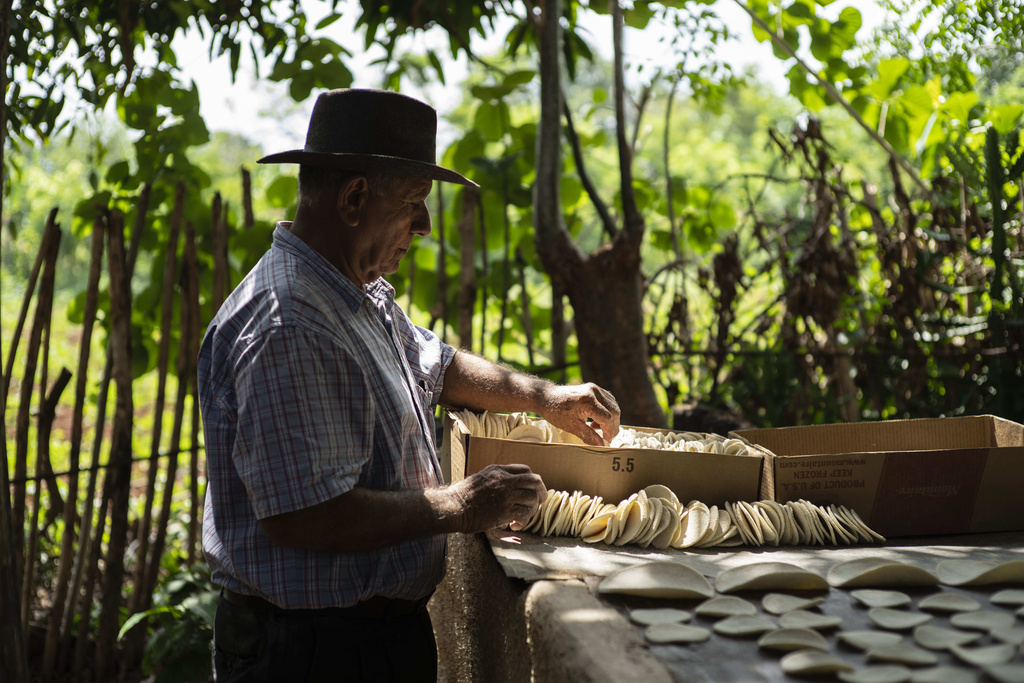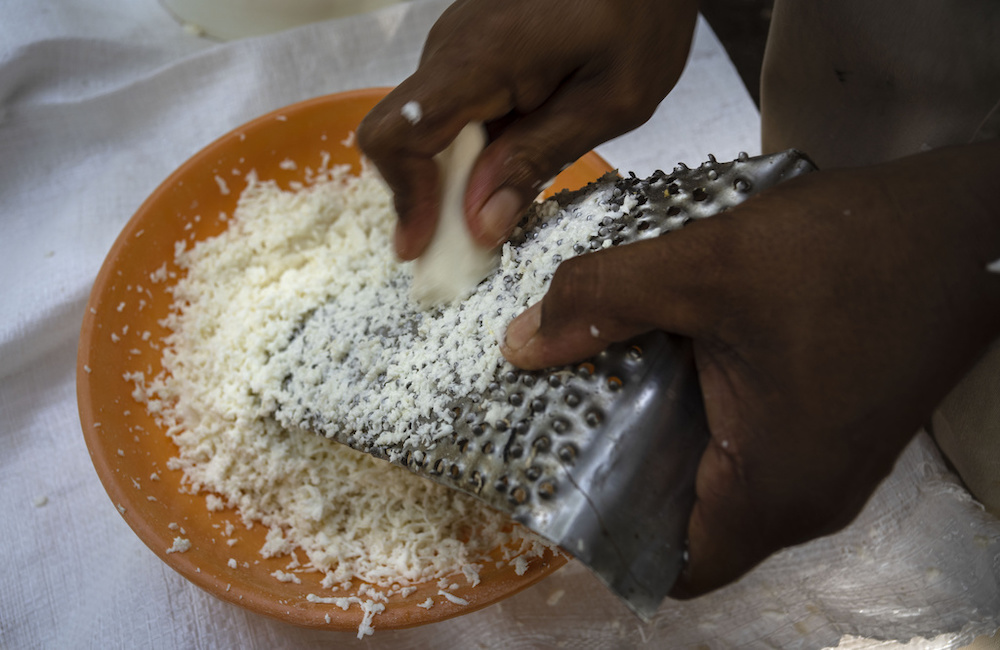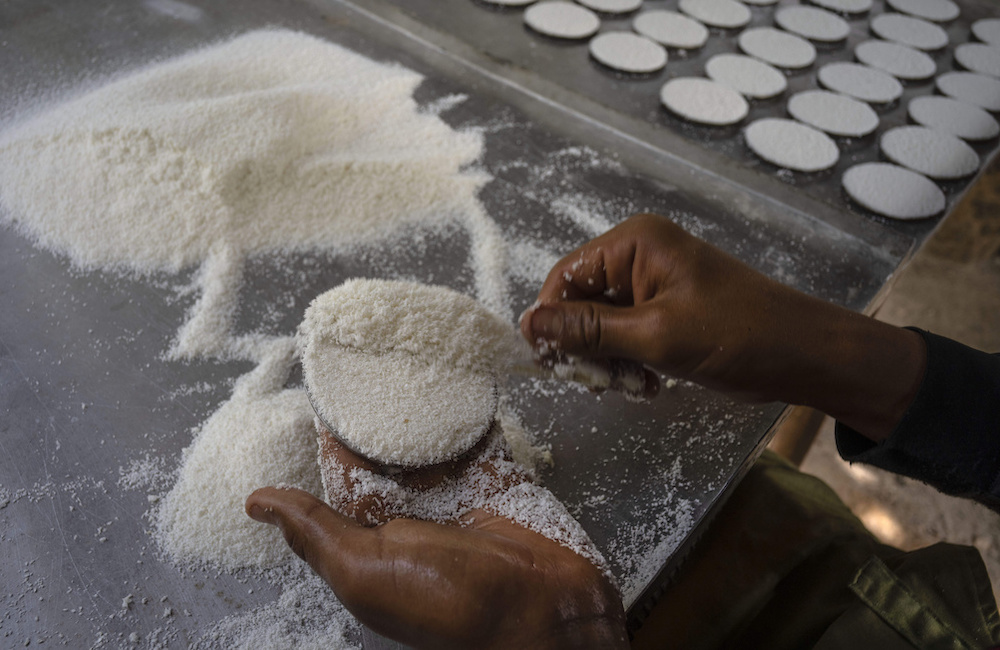フリオ・セザール・ヌニェスさんは幼いころ、一からカサベを作る祖母を手伝ったという。専用の道具と昔ながらの調理法で、ユカの根(別名:キャッサバ)を薄くすりおろし、白く歯ごたえのよい平たいパンに仕上げる。
80歳になったヌニェスさんは、今もハバナ南部の町キビカンで、若い世代の家族とともに収穫から調理まで、カサベ作りの伝統を守っている。ただ、それはもはや自分たちで食べるためだけではなく、首都の小さな商店やレストランに販売している。

薪火の上の鉄板で小さなカサベのケーキを作るカサベ生産者のフリオ・セサール・ヌニェスさん(左)と甥のアグスティンさん。AP Photo / Ramon Espinosa
カサベは、ユカの根で作った平たいパンのこと。キューバで最も古い先住民食の一つだ。今、このカサベが島国キューバで復活の兆しを見せている。グルテンフリーのパンの代用品として、またユネスコ無形文化遺産への登録を目指し、プロモーターやレストランがその魅力をアピールしているのだ。
キューバ国家遺産評議会のソニア・ビルヘン・ペレス会長はAP通信に対し「カサベは南米北部からアンティル諸島に渡ってきたネイティブアメリカンの伝統料理です。それがキューバ東部に伝わり、代々受け継がれる大切な食べ物になりました」と述べている。
3月、ペレス会長はキューバ、ドミニカ共和国、ベネズエラ、ホンジュラス、ハイチを含む国々の代表団を率いてユネスコを訪れ、ユカの収穫、カサベの調理および消費の伝統を文化遺産に加えることを正式に要請した。
カリブの先住民の食生活を語る上で、カサベは欠かすことができない。また、この地にたどり着いたスペイン人が最初に取り入れた現地食でもある。彼らがカサベを食卓に受け入れたのは、長期保存が可能だからだ。焼き上げた後も数ヶ月は保存できるという。
- ユカの根をすりおろすヌニェスさん。AP Photo / Ramon Espinosa
- 丸い型を使ってカサベを成形するカサベ生産者のエリエル・ヌネスさん。 AP Photo / Ramon Espinosa
- ユカの根を剥くアグスティン・ヌネスさん。AP Photo / Ramon Espinosa
カサベは同じラテンアメリカの伝統料理であるメキシコのトルティーヤ(トウモロコシ由来)や、厚みのあるベネズエラのアレパと比べると知名度は低いものの、今ではフード系のフェスティバルに並ぶこともあるほか、カサベをテーマにした商品も増えてきている。ペレスは、主材料であるユカの根がキューバの農村地方ならどこでも手に入る点もメリットだとした上で「カサベは、強さと回復力の代名詞です」と言う。
食べるとカリカリで、ドライなクッキーのような食感が特徴。ココナッツのようなスイーツはもちろん、肉や鶏肉ともよく合うが、乾燥したテクスチャーのカサベはしっとりした水分の多い食品と相性がいい。

ユカサビ・レストランにて。他のユカ根料理とともにカサベの準備を描いた壁画AP Photo / Ramon Espinosa
ハバナでカサベを使った料理の専門店「ユカサビ」を共同経営する経済学者、ユディスリー・クルスさん(45歳)は、「私たちの料理のなかで最も歴史の長い食品の一つです。何にでも合うんです」と話す。
マヤベケ州のキビカンでは、冒頭のヌニェスさんが記者に農場を案内し、天然繊維でできたふるいなど、祖母から受け継いだ伝統的なカサベ作りの道具を見せてくれた。数メートル先では、甥のアグスティンさん(40歳)がユカの根をすりおろし、その息子エリエル君(15歳)は丁寧に準備したカサベのたねを鉄板にのせ、薪の火にかけて調理している。

キューバのキビカンでユカの根の世話をする甥のオーガスティンと息子のエリエルを見守る。AP Photo / Ramon Espinosa
カサベの愛好家は無形文化財登録を目指すだけでなく、先住民の伝統を守りながら、より多くの人々の舌を楽しませる健康的で持続可能な食品として広く受け入れてほしいと望んでいる。
レストラン経営者のクルスさんは「パンに対抗するつもりはありません。カサベも食べてほしいんです」と語る。

調理したてのカサベを集めるカサベ生産者のヌニェスさん。AP Photo / Ramon Espinosa
—
By ANDREA RODRÍGUEZ Associated Press
QUIVICÁN, Cuba (AP)
When Julio César Núñez was a child, he helped his grandmother make casabe from scratch, using artisanal tools — and an ancient cooking method — to turn grated yuca root into a thin, white, crispy flatbread.
Today, Núñez, 80, and a younger generation of family members in this town south of Havana, continue the tradition of harvesting and preparing casabe the ancestral way, but it’s no longer just for their own consumption. They sell it to small businesses and restaurants in the capital.
Casabe, a flatbread made of yuca root, which is also called cassava, is one of Cuba’s oldest Indigenous meals. It is making a comeback on the island nation, with promoters and restaurants hyping its benefits as a gluten-free alternative to bread and officials seeking its addition to the prized intangible cultural heritage list of UNESCO, the U.N.’s cultural agency.
“Casabe is an Amerindian tradition that came from northern South America and made its way to the Antilles,” Sonia Virgen Pérez, president of Cuba’s National Heritage Council, told The Associated Press. “It arrived through the eastern part of Cuba and became an important food that has been passed down from generation to generation.”
In March, Pérez led a delegation of countries including Cuba, Dominican Republic, Venezuela, Honduras and Haiti, to formally request that UNESCO include the tradition of harvesting yuca, and preparing and consuming casabe to its cultural heritage list.
Casabe was a key part of the diet of Indigenous peoples in the Caribbean. It was also among the first native products embraced by the Spaniards upon their arrival. They incorporated it into their diet, partly because of its durability. It can last months once baked.
Less popular than its Latin American cousins — the Mexican tortilla, traditionally made of corn, or the Venezuelan arepa, which tends to be thicker – casabe is increasingly finding its way into culinary festivals and even casabe-themed merchandising. Among its advantages, says Pérez, is that its main ingredient, the yuca root, can be found virtually anywhere in the Cuban countryside.
“Casabe is a synonym for strength and resilience,” she says.
When eaten, casabe resembles a crunchy, somewhat dry cookie that can be accompanied with either sweet foods, such as sugary coconut, or meat and poultry, as long as the addition is moist enough to compensate for casabe’s natural dryness.
“It is one of the oldest dishes in our cuisine,” says Yudisley Cruz, a 45-year-old economist who co-owns Yucasabi, a restaurant in Havana that specializes in dishes based on casabe flatbread. “It goes with everything.”
Back in Quivicán, Núñez walks around the farm, showing a reporter some of the traditional tools he uses to make casabe the way his grandmother did, including a sifter made of natural fibers. A few meters away, his 40-year-old nephew Agustín grates the yuca root while Agustín’s son, Eriel, 15, carefully prepares the small cakes that are then cooked on a griddle over a wood fire.
In addition to seeking UNESCO recognition, casabe enthusiasts hope it will be widely embraced as a healthy, sustainable meal that delights the palate of more people while preserving an Indigenous tradition.
“We’re not going to war against bread. We just want people to also eat casabe,” says Cruz, the restaurateur.
—
By ANDREA RODRÍGUEZ Associated Press
QUIVICÁN, Cuba (AP)






